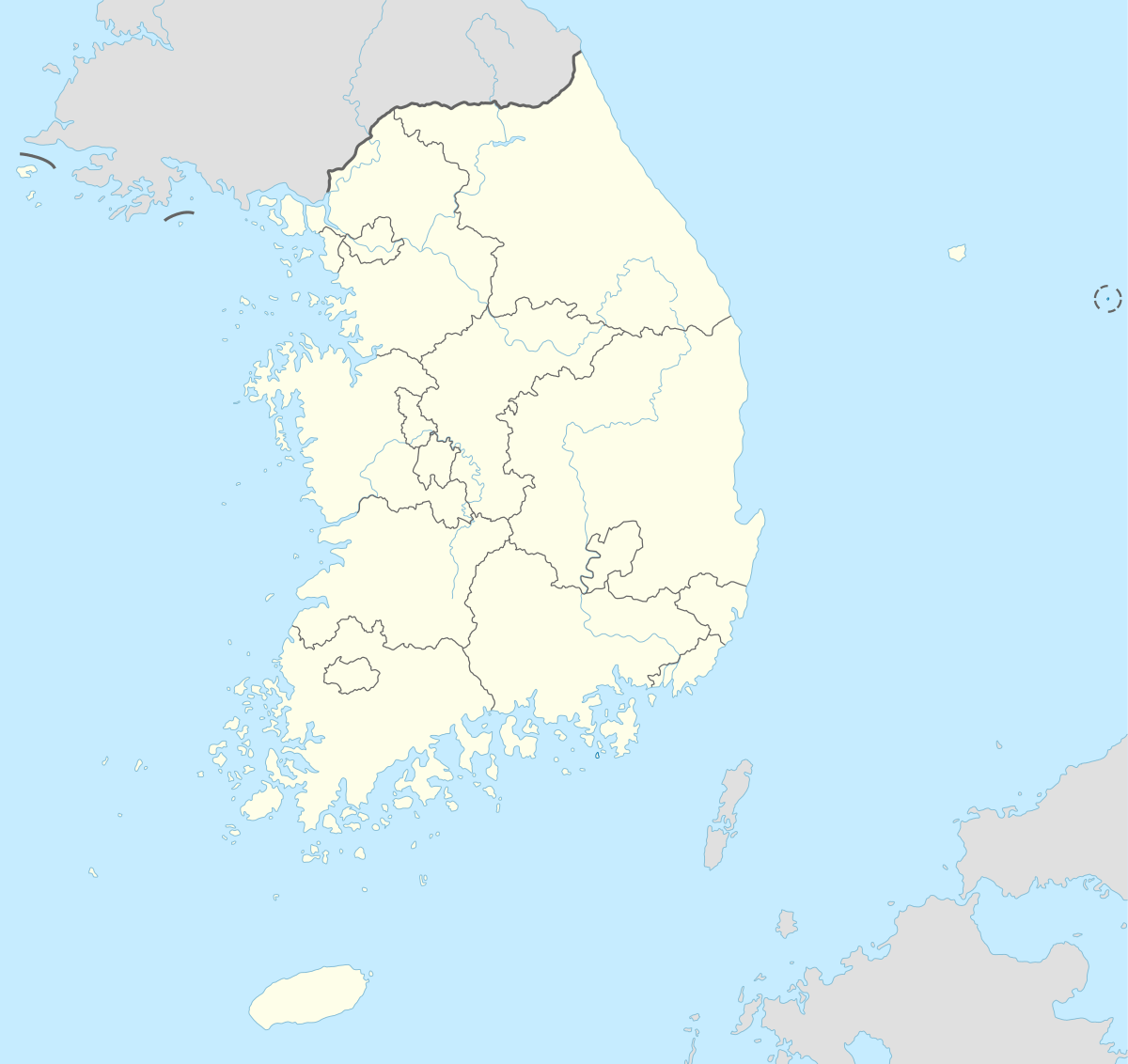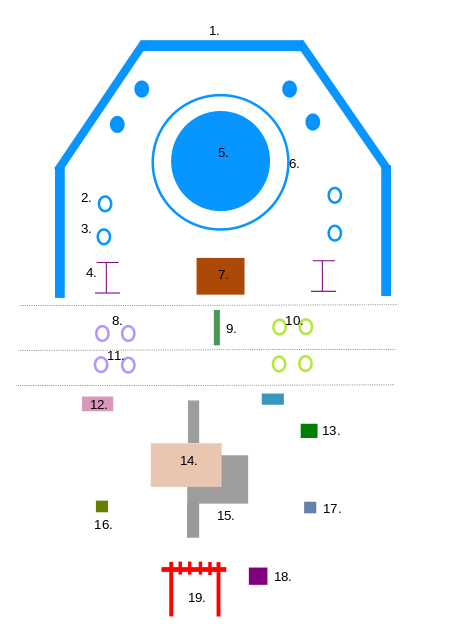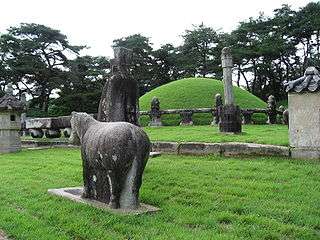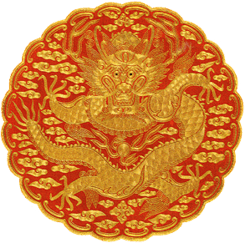Royal Tombs of the Joseon Dynasty
| Royal Tombs of the Joseon Dynasty | |
|---|---|
|
Yeongneung | |
| Location | Gyeonggi-do and Seoul, South Korea |
| Coordinates | 37°33′02″N 127°00′35″E / 37.55056°N 127.00972°ECoordinates: 37°33′02″N 127°00′35″E / 37.55056°N 127.00972°E |
| Built | Joseon Dynasty |
| Governing body | Cultural Heritage Administration of Korea |
| Type | Cultural |
| Criteria | iii, iv, vi |
| Designated | 2009 (33rd session) |
| Reference no. | 1319 |
| State Party |
|
| Region | Asia and Australasia |
 Joseon Tombs in South Korea | |
| Royal Tombs of the Joseon Dynasty | |
| Hangul | 조선왕릉 |
|---|---|
| Hanja | 朝鮮王陵 |
| Revised Romanization | Joseon wangneung |
| McCune–Reischauer | Chosŏn wangnŭng |
| Wikimedia Commons has media related to Royal Tombs of the Joseon Dynasty. |
The Tombs of the Joseon Dynasty refers to the 40 tombs of members of the Korean Joseon Dynasty (1392–1910). These tombs are scattered in over 18 locations across South Korea. They were built to honor and respect the ancestors and their achievements, and assert their royal authority.[1] The tombs have been registered as a UNESCO World Heritage site since 2009.
Structure of the Tombs
The royal tombs can be divided into three main parts:
The part around Jeongjagak
It is the meeting point between the dead and the living.The area around Hongsalmun gate is the space for the living.
The area just past the gate
This is the space between the earthly and the holy. This is the area where the spirits of the kings and queens meet their earthly worshippers. This area also contains the Jeongjagak shrine, the Subokbang, and the Suragan buildings.
The sacred ground of the grave mounds
This area also includes the wall, and the other stone structures.[2]
Other structures

Other structures include:[2]
- Gokjang These are the three sides of walls around the grave mound that protects the sacred area.
- Seokho The tiger deity which serves as the guardian of the Bongbun.
- Seogyang A sheep statue which fends off the evil spirits from earth and prays for the souls of the departed.
- Mangjuseok This is a pair of stone pillars erected on both sides of the mound.
- Bongbun This is where the body of the king or queen lies. It is also called Neungchim or Neungsang.
- Nanganseok It is the hedge-like stone which protects the Byeongpungseok.
- Honnyuseok A rectangular stone erected in front of the mound which is believed to invite the soul to come out and play.
- Muninseok Statues of scholars placed on the left and right sides of the Jangmyeongdeung lantern.
- Jangmyeongdeung A lantern which comforts and prays blessing over the soul.
- Seongma A horse statue.
- Muinseok Statue of a soldier said to be guarding the king and is placed below the Muninseok.
- Yegam It is located on the left-side corner behind the Jeongjagak and is used for burning the written prayers after a burial service.
- Bigak A building which has a stone monument where the names of the king and the queen are written at the front, while at the back was written the list of the king's accomplishments.
- Jeongjagak This is where memorial services are held.
- Chamdo These are two stone-covered paths that leads to the Jeongjagak. The higher path is called Sindo (The Path of the Gods), while the lower path is called Eodo (The Path Of the King). Only the Eodo path can be used by visitors in accordance to Korean custom.
- Suragan This is where the food for the memorial services are brought and prepared.
- Subokbang This is the living quarter of the officer guarding the tomb.
- Baewi This is where the king and memorial service officials knelt in honor of the deceased king. It is also called Panwi or Eobaseok.
- Hongsalmun This is the gate with two red cylindrical pillars.
- Byeongpungseok It is the stone which was placed underneath and around to protect the Bongbun.
Tombs
The tombs are classified into two types. Tombs of the kings and queens and those posthumously granted the title of king or queen, were interred in neung-type tombs. Crown princes and their wives, as well as the parents of royalty, were interred in won-type tombs. The royal tombs are scattered over 18 locations, with many of them located 40 kilometers from Hanseong (present-day Seoul). Indeed, the Jangneung tomb is in Yeongwol, Gangwon-do, while the Yeongneung tombs are in Yeoju, Gyeonggi-do. Tombs were made for individuals as well as family groups. There are 40 neung-type and 13 won-type tombs, thus creating a total of 53 royal tombs.
Joseon-era royal tombs followed the guidelines outlined in Chinese Confucian texts, such as the Book of Rites (Li Ji) and the Rites of Zhou (Zhou Li). Many factors went into consideration when deciding the location of a tomb, such as the distance from Hanyang, the distance in relation to other royal tombs, the accessibility of the location, and Korean traditions of pungsu (geomancy). The tomb construction also took into account traditional burial rituals of Korea and the natural environment.
There now follows a list (in alphebatical order) of the individual (or clusters of) tombs. There are two more royal tombs from the Joseon Dynasty in Kaesong, North Korea, namely Jereung (제릉) (the tomb of Queen Sinui, who was King Taejo's first consort) and Hureung (후릉) (the tomb of King Jeongjong and Queen Jeongan).[3]
Donggureung Tomb Cluster (동구릉)
37°37′11″N 127°07′53″E / 37.61972°N 127.13139°E
This cluster of tombs represents the best sample of royal family group tombs from the Joseon Dynasty. Seven kings and ten queens are interred in nine neung-type tombs. Notable tombs in this group include the Geonwolleung tomb (건원릉) for King Taejo, the founder of the Joseon Dynasty. The Gyeongneung tomb (경릉) holds the remains of King Heonjong, who ruled from 1834 to 1849, and his wives Queen Hyohyeon and Queen Hyojeong. This group of tombs represents the evolution of Joseon-style tomb architecture over a period of five hundred years. The other tombs in the cluster are named Hyereung (혜릉), Hwirung (휘릉), Mongneung (목릉), Sungneung (숭릉), Sureung (수릉) and Wolleung (원릉). This cluster is situated on the west bank of the Wangsukcheon Stream in the city of Guri, Gyeonggi Province.[4]
Gwangneung (광릉)
37°45′08″N 127°10′38″E / 37.75222°N 127.17722°E
Gwangneung is a pair of tombs in Namyangju City, Gyeonggi Province. The tombs, arranged in a V shape, contain the remains of King Sejo and his wife Queen Jeonghui. The two tombs were built in 1468 and 1483 respectively. Gwangneung is important because changes taking place in the construction of royal tombs are evident in its construction. Screening rocks were not installed at this tomb. Instead of an outer coffin stone, quicklime was used. Another break from tradition was that the reverential access was not built. Finally, only one T-shaped ritual shrine was built for both burial mounds. This change in tomb architecture came from the last wishes of the king and reflects a new frugal style that influenced later royal tomb construction.
Heolleung and Illeung (헌릉&인릉)
Heolleung: 37°27′58″N 127°04′59″E / 37.46611°N 127.08306°E
Illeung: 37°27′58″N 127°04′50″E / 37.46611°N 127.08056°E
These tombs are in the south of Seoul, at the bottom of the southern slope of Daemosan. Heolleung is a conjoined pair of tombs, while Illeung stands alone two hundred metres to the west.
Hongneung and Yureung (홍릉&유릉)
Hongneung: 37°37′52″N 127°12′45″E / 37.63111°N 127.21250°E
Yureung: 37°37′50″N 127°12′33″E / 37.63056°N 127.20917°E
Yeongwon: 37°37′46″N 127°12′56″E / 37.62944°N 127.21556°E
The styles of these two tombs reflect the political changes Korea was experiencing during the waning days of the Joseon Dynasty. With the declaration of the Korean Empire, the style of the tombs of the last two rulers of the Joseon Dynasty, Emperor Gojong and Emperor Sunjong were designed to reflect their new status. Hongneung holds the remains of Emperor Gojong and Empress Myeongseong. Yureung tomb holds the remains of Emperor Sunjong, Empress Sunmyeonghyo and Empress Sunjeonghyo. Other notable tombs include Yeongwon (영원), the tomb of Crown Prince Yeongwang and Crown Princess Yi Bangja. The tombs are located in the city of Namyangju, just to the east of Seoul.
Jangneung (Gimpo) (김포 장릉)
37°36′47″N 126°42′40″E / 37.61306°N 126.71111°E
There are three locations with Joseon tombs named Jangneung. This particular double tomb is found in Gimpo near the border with Incheon.
Jangneung (Paju) (파주 장릉)
37°46′25″N 126°42′29″E / 37.77361°N 126.70806°E
This tomb is located in Paju, near the confluence of the Rivers Imjin and Han, where the Osusan Observatory overlooks North Korea..
Jangneung (Yeongwol) (영월 장릉)
37°11′51″N 128°27′11″E / 37.19750°N 128.45306°E
This tomb lies in the county of Yeongwol, Gangwon Province. It is the furthest from capital.
Jeongneung (정릉)
37°36′08″N 127°00′21″E / 37.60222°N 127.00583°E
Not to be confused with the more famous Jeongneung beside Seolleung or the Jeongneung area of Bukhansan, this tomb is also in Seoul, but north of the river.
Olleung (온릉)
37°43′13″N 126°57′04″E / 37.72028°N 126.95111°E
Olleung is a tomb located in Yangju, just to the north of the Seoul Ring Expressway's Songchu exit.
Paju Samneung Cluster (파주 삼릉)
Gongneung: 37°44′45″N 126°49′48″E / 37.74583°N 126.83000°E
Sulleung: 37°44′37″N 126°50′11″E / 37.74361°N 126.83639°E
Yeongneung: 37°44′33″N 126°50′01″E / 37.74250°N 126.83361°E
This is a cluster of three tombs named Gongneung (공릉), Sulleung (술릉) and Yeongneung (영릉), in the city of Paju. Yeongneung, a pair of tombs, is not to be confused with King Sejong's tomb in Yeoju.
Sareung (사릉)
37°38′50″N 127°11′51″E / 37.64722°N 127.19750°E
This tomb is in Namyangju, 1.6 km from Geumgok Station.
Seolleung and Jeongneung (선릉&정릉)
Seolleung: 37°30′32″N 127°02′44″E / 37.50889°N 127.04556°E
Jeongneung: 37°30′32″N 127°03′07″E / 37.50889°N 127.05194°E
Seolleung and Jeongneung are in the south of Seoul. Jeongneung is not to be confused with its namesake on the southern slopes of Bukhansan, also in Seoul. The tombs are in a park, the entrance of which is 340 metres from Seolleung Station.
Seo-oreung Cluster (서오릉)
Changneung: 37°38′09″N 126°53′42″E / 37.63583°N 126.89500°E
Hongneung: 37°37′58″N 126°53′38″E / 37.63278°N 126.89389°E
Gyeongneung: 37°37′47″N 126°53′38″E / 37.62972°N 126.89389°E
Ingneung: 37°37′47″N 126°54′02″E / 37.62972°N 126.90056°E
Myeongneung: 37°37′31″N 126°54′04″E / 37.62528°N 126.90111°E
Daebinmyo: 37°37′49″N 126°53′32″E / 37.63028°N 126.89222°E
Sugyeongwon: 37°37′38″N 126°54′02″E / 37.62722°N 126.90056°E
Sunchangwon: 37°37′45″N 126°53′50″E / 37.62917°N 126.89722°E
This is a group of tombs in Goyang. The tombs are named Changneung (창릉) (which is a pair of tombs), Hongneung (홍릉), Gyeongneung (경릉), Ingneung (익릉) and Myeongneung (명릉) (which is a trio of tombs: one alone and another two joined as a pair). Other notable tombs here include Daebinmyo (대빈묘), Sugyeongwon (수경원) and Sunchangwon (순창원).
Seosamneung Cluster (서삼릉)
Huineung: 37°39′49″N 126°52′14″E / 37.66361°N 126.87056°E
Hyoreung: 37°39′53″N 126°51′51″E / 37.66472°N 126.86417°E
Yereung: 37°39′56″N 126°52′07″E / 37.66556°N 126.86861°E
Hoimyo: 37°39′58″N 126°51′32″E / 37.66611°N 126.85889°E
Hyochangwon: 37°39′50″N 126°52′02″E / 37.66389°N 126.86722°E
Uiryeongwon: 37°39′50″N 126°52′02″E / 37.66389°N 126.86722°E

The Seosamneung (lit. "Three Western Neung") tomb cluster is located in Goyang, Gyeonggi Province, 20 kilometres (12 mi) from Seoul. The name of the tombs comes from the three royal tombs' (neung) location in the western suburb of the capital. Queen Janggyeong was interred in Huineung tomb (휘릉), while Hyoreung (효릉), a joined pair of tombs, holds the remains of King Injong and his wife Queen Insong. King Cheoljong and Queen Cheolin are interred in Yereung (예릉), another joined pair of tombs. Fifty other tombs, most notably Hoimyo (회묘), Hyochangwon (효창원) and Uiryeongwon (의령원), holding the remains of princes, princesses, and royal concubines, are also located in this cluster. Notably, monuments in various styles built to house the royal placenta and umbilical cords, known as taesil, which had once been scattered all over Korea, have been gathered and now rest in this tomb cluster.
Taereung and Gangneung (태릉&강릉)
Taereung: 37°38′05″N 127°05′49″E / 37.63472°N 127.09694°E
Gangneung: 37°38′24″N 127°06′19″E / 37.64000°N 127.10528°E
Taereung and Gangneung are located in eastern Seoul. Gangneung is a joined pair of tombs approximately a kilometre east of Taereung.
Uireung (의릉)
37°36′13″N 127°03′25″E / 37.60361°N 127.05694°E
Uireung is a pair of tombs arranged in line. This tomb is in Seokgwan-dong, Seoul.
Yeongneung and Yeongneung (영릉&영릉)
Yeongneung (King Hyojong): 37°18′50″N 127°36′32″E / 37.31389°N 127.60889°E
Yeongneung (King Sejong): 37°18′29″N 127°36′11″E / 37.30806°N 127.60306°E

These identically-named tombs lie in the west of the city of Yeoju. Sejong the Great and his wife, Queen Soheon are within a burial mound, surrounded by statues and near a pond and memorial shrine.[5] King Hyojong. King Hyojong's tomb lies in line with the tomb of his wives.
Yungneung and Geolleung (융릉&건릉)
Geolleung: 37°12′50″N 126°59′17″E / 37.21389°N 126.98806°E
Yungneung: 37°12′42″N 126°59′38″E / 37.21167°N 126.99389°E
Yungneung and Geolleung, within a park in Hwaseong, Gyeonggi-do, house Crown Prince Sado and Princess Hyegyeong (posthumously named Emperor Sangjo and Empress Heongyeong, and King Jeongjo and Queen Hyoui.
See also
References
- ↑ "Royal Tombs of the Joseon Dynasty - UNESCO World Heritage Centre)". UNESCO. Retrieved 2010-10-22.
- 1 2 A Trip to Royal Tombs of the Joseon Dynasty : Public Gardens for the Living and the Dead in the Vicinity of Seoul. English.visitkorea.or.kr. Retrieved on 2013-07-12.
- ↑ "Royal Tombs to Be Listed as World Heritage Site". Chosun Ilbo. 2009-05-14. Retrieved 2015-11-24.
- ↑ Official Site of Korea Tourism Org.: The 40 Royal Tombs of the Joseon Dynasty. Visitkorea.or.kr. Retrieved on 2013-07-12.
- ↑ Korea Tourism Organization (July 13, 2011). "Queen Soheon". Plan your trip Korea: Tour courses for international tourists. 길잡이미디어. p. 31. GGKEY:TFU8B87WQG3.

